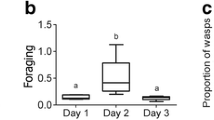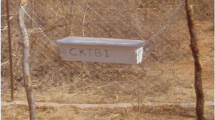Abstract
Using simple stochastic models, we discuss how cooperative breeders, especially wasps and bees, can improve their productivity by reducing foraging work. In a harsh environment, where foraging is the main cause of mortality, such breeders achieve greater productivity by reducing their foraging effort below full capacity, and they may thrive by adopting cooperative breeding. This could prevent the population extinction of cooperative breeders under conditions where a population of lone breeders cannot be maintained.





Similar content being viewed by others
References
Cant MA, Field J (2001) Helping effort and future fitness in cooperative animal societies. Proc R Soc Lond B Biol Sci 268:1959–1964. http://rspb.royalsocietypublishing.org/content/268/1479/1959.abstractN2
Field J (1996) Patterns of provisioning and iteroparity in a solitary halictine bee, Lasioglossum (evylaeus) fratellum (perez), with notes on. (e.) calceatum (scop.) andl. (e.) villosulum (k.). Insectes Soc 43:167–182
Field J (2005) The evolution of progressive provisioning. Behav Ecol 16:770–778. http://beheco.oxfordjournals.org/content/16/4/770.abstract
Field J (2008) The ecology and evolution of helping hover wasps. In: Korb JHJ (ed) Ecology of social evolution, chap 4. Springer, Berlin, pp 83–105
Field J, Shreeves G, Sumner S, Casiraghi M (2000) Insurance-based advantage to helpers in a tropical hover wasp. Nature 404:869–871. doi:10.1038/35009097
Field J, Turner E, Fayle T, Foster WA (2007) Costs of egg-laying and ospring provisioning: multifaceted parental investment in a digger wasp. Proc R Soc B Biol Sci 274: 445–451. http://rspb.royalsocietypublishing.org/content/274/1608/445
Field J, Paxton R, Soro A, Craze P, Bridge C (2012) Body size, demography and foraging in a socially plastic sweat bee: a common garden experiment. Behav Ecol Sociobiol 66:743–756. doi:10.1007/s00265-012-1322-7
Gadagkar R (1990) Evolution of eusociality: the advantage of assured fitness returns. Philos Trans Biol Sci 329:17–25. http://www.jstor.org/stable/76892
Gordon DM (2013) The rewards of restraint in the collective regulation of foraging by harvester ant colonies. Nature 498:91–93. doi:10.1038/nature12137
Hamilton W (1964) The genetical evolution of social behaviour. ii. J Theor Biol 7:17–52
Heinsohn R, Legge S (1999) The cost of helping. Trends Ecol Evol 14:53–57. doi: 10.1016/s0169-5347(98)01545-6. http://www.sciencedirect.com/science/article
Kokko H, Johnstone RA (1999) Social queuing in animal societies: a dynamic model of reproductive skew. Proc R Soc Lond B Biol Sci 266:571–578. doi: 10.1098/rspb.1999.0674.
Kokko H, Johnstone RA, Clutton-Brock TH (2001) The evolution of cooperative breeding through group augmentation. Proc R Soc Lond B Biol Sci 268:187–196. http://www.journals.royalsoc.ac.uk/content/en6x5dgrht76ulhw
Nonacs P, Liebert A, Starks P (2006) Transactional skew and assured fitness return models fail to predict patterns of cooperation in wasps. Am Nat 167:467–480
Queller D (1989) The evolution of eusociality: reproductive head starts of workers. PNAS 86:3224–3226
Queller D (1994) Extended parental care and the origin of eusociality. Proc R Soc Lond B Biol Sci 256:105–111
Queller D (1996) The origin and maintenance of eusociality: the advantage of extended parental care. Natural history and evolution of paper wasps. Oxford University Press, Oxford, pp 218–234
Shen SF, Kern Reeve H (2010) Reproductive skew theory unified: The general bordered tug-of-war model. J Theor Biol 263:1–12. http://www.sciencedirect.com/science/article/B6WMD-4XRYTBM-3/2/15051acaa41548cf09231c01f66303a5
Shen SF, Kern Reeve H, Vehrencamp SL (2011) Parental care, cost of reproduction and reproductive skew: a general costly young model. J Theor Biol 284:24–31. http://www.sciencedirect.com/science/article/pii/S0022519311002803
Shreeves G, Field J (2002) Group size and direct fitness in social queues. Am Nat 159:81–95
Shreeves G, Cant MA, Bolton A, Field J (2003) Insurance-based advantages for subordinate co-foundresses in a temperate paper wasp. Proc R Soc Lond B Biol Sci 270:1617–1622. http://rspb.royalsocietypublishing.org/content/270/1524/1617.abstract
Author information
Authors and Affiliations
Corresponding author
Appendix
Appendix
1.1 E[H] for Cooperative Breeders
Let H i be the number of dispersers reared in the interval (i, i + 1). The matured brood from the initial maturation cycle stay in the nest, so H 0 = 0. Thus,
Assume the single cooperative breeder who founded the nest succeeded in rearing the first brood, and let H′ be the total number of dispersers by conditioning to this case. Because the first matured brood stay in the nest, there exist two adults at time 1. Indeed, until the termination of the nest, two cooperative breeders always exist at the start of each maturation cycle (see Fig. 3). In the maturation cycle (1, 2), depending on the survival of the adults, there are three possibilities: (a) two adults survive and the matured brood disperse at time 2, (b) one of the two adults dies and the brood stay in the nest, and (c) both adults die and the nest is terminated. As the death of the adults is a Poisson process with intensity μ 2, we have
After time 2, dispersal from a nest of two cooperative breeders will be repeated stochastically in the same manner, and H 2 + H 3 + … is stochastically equivalent to \(H^{\prime}\). Thus, taking the expectation on both sides of (8), we have
Rearranging this, we have
Because the death of the founding single breeder is exponentially distributed with the rate μ 1, we have
Rights and permissions
About this article
Cite this article
Toyoizumi, H., Field, J. Reduction of Foraging Work and Cooperative Breeding. Acta Biotheor 62, 123–132 (2014). https://doi.org/10.1007/s10441-014-9213-0
Received:
Accepted:
Published:
Issue Date:
DOI: https://doi.org/10.1007/s10441-014-9213-0




